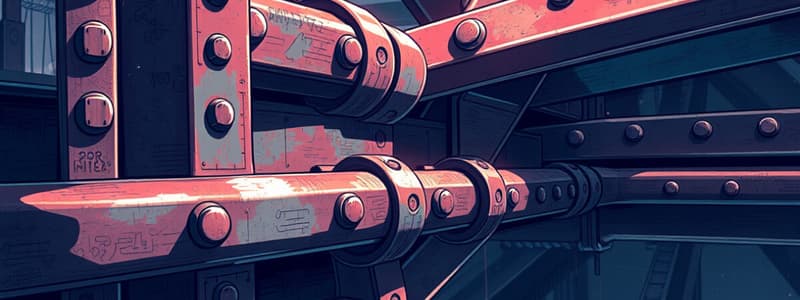Podcast
Questions and Answers
Which type of connection is NOT commonly used in steel structures?
Which type of connection is NOT commonly used in steel structures?
- Bolted connection
- Welded connection
- Screwed connection (correct)
- Riveted connection
What are the main types of connections used in steel structures?
What are the main types of connections used in steel structures?
- Welded, screwed, and welded
- Pinned, bolted, and glued
- Riveted, glued, and pinned
- Riveted, bolted, and welded (correct)
Which type of connection typically offers the highest strength?
Which type of connection typically offers the highest strength?
- Welded connection (correct)
- Riveted connection
- Screwed connection
- Bolted connection
In which scenario is a riveted connection primarily preferred?
In which scenario is a riveted connection primarily preferred?
How many types of connections are mentioned for steel structures?
How many types of connections are mentioned for steel structures?
Study Notes
Types of Connections in Steel Structures
- Various elements in steel structures require strong connections for stability and load-bearing.
- Common types of connections include riveted, bolted, and welded connections.
Riveted Connections
- A method employing rivets to join components, providing significant structural integrity.
- Commonly used in bridges and buildings for their durability and ability to withstand dynamic loads.
Bolted Connections
- Utilizes bolts to fasten components together, allowing for ease of assembly and disassembly.
- Offers flexibility in design and repair, with various types of bolts (e.g., high-strength) enhancing performance.
Welded Connections
- Involves melting together materials at their interface to form a continuous joint.
- Provides a strong, permanent bond and is useful in applications where smooth surfaces are required.
Strength of Plates
- The design strength of plates is critical in determining the overall strength of joints.
- Plate thickness and material properties influence the load capacities of connections.
Strength of Riveted Joints
- Riveted joints can effectively transmit loads through the rivets, offering a reliable connection method.
- The quality and placement of rivets significantly impact joint strength and reliability under load.
Studying That Suits You
Use AI to generate personalized quizzes and flashcards to suit your learning preferences.
Related Documents
Description
This quiz explores different types of connections used in steel structures, with a specific focus on riveted connections. Test your knowledge on the strength of plates and riveted joints, and understand the essential concepts of steel structure connections. Ideal for civil engineering students or professionals looking to refresh their knowledge.




